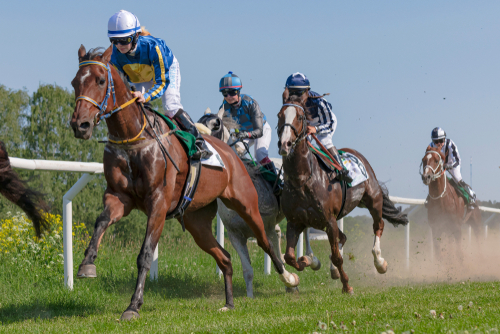To earn the accolade of greatness in any field is obviously a subjective matter. Shakespeare’s take on the subject was “Some are born great, some achieve greatness, and some have greatness thrust upon them.” How about great racehorses? In no particular order, here’s a brief narrative on what many plaudits would consider five of the greatest racehorses of all time:
Red Rum (1965 – 1995)
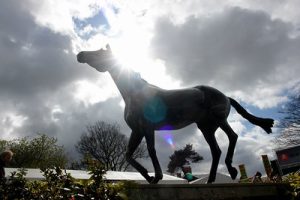
Photo credit: CC via Flickr (CC BY-NC-SA 2.0)
The Grand National is often described as “The world’s greatest steeplechase”. For no other reason than the 4 ½ mile Aintree (Liverpool) course has some of the toughest jumps on the planet. Thus, it’s recognised in racing circles that it takes an extra special horse to win the ‘National’. The Irish champion thoroughbred ‘Red Rum’ was such a horse.
Red Rum is the only horse to win the Grand National three times. He achieved the historic treble in 1973, 1974, and 1977, as well as finishing second in 1975 and 1976. And, while six horses have won both the English and Scottish Grand Nationals, Red Rum is the only one to do so in the same year (1974). Renowned for his great jumping ability, he never ever fell in any of his 100 races.
The 1973 race saw Red Rum snatch victory after coming from 30 lengths behind, in what is by many considered by many to be the greatest Grand National ever. His historic third triumph in the 1977 Grand National, winning by 25 lengths, is seen as one of the greatest sporting moments of all time. He retired from racing in 1978 and died in 1995, aged 30. In memory of the great horse, a life-size bronze statue has been erected on the grounds of the Aintree racecourse. Red Rum himself is buried opposite the winning post of the world-famous racecourse.
Arkle (1957 – 1970)

Photo credit: Mick Atkins/Shutterstock.com
Born in 1957, Arkle was an Irish Thoroughbred racehorse that competed in both flat and jump races. Overall, the great horse won 27 of the 35 races in which he competed. Twenty-two of the wins came in the 26 steeplechases where he came under starters orders. Furthermore, he was placed in the other 4 races. Arkle’s major wins include three successive Cheltenham Gold Cups (1964 – 1966), the King George VI Chase (1965), the Irish Grand National (1964), the Hennessy Gold Cup (1965) the Gallaher Gold Cup (1965), and the Whitbread Gold Cup (1965).
Arkle ran his last race on 27 December 1966 in the King George VI Chase at Kempton Park. He fractured a bone in his foot during the race but still managed to finish second. His leg was placed in plaster for four months and he made a good recovery but never raced again. He was retired to Bryanstown, County Louth, Ireland by his owner. By 1969, Arkle’s physical condition began to deteriorate. With his hind legs showing signs of arthritis, he appeared to be in pain and found walking increasingly difficult. Arkle was put to sleep, aged 13, and buried in Bryanstown in May 1970.
Shergar (1978 – 1983)
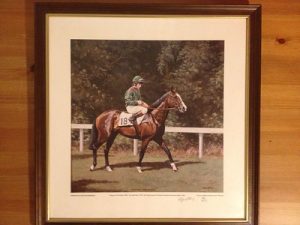
Creative Commons (CC BY-NC-SA 2.0)
Shergar arguably has the most ill-fated reputation of any racehorse in history. He was foaled on 3 March 1978 at Sheshoon, County Kildare, Ireland. The Irish-bred Thoroughbred racehorse was trained at Newmarket, England for his owner the Aga Khan. His first race was as a 2-year-old at Newbury on 19 September 1980. Ridden by Lester Piggott, Shergar won the race by 2 ½ lengths. Later that year, again ridden by Lester Piggott, he finished second at Doncaster. In 1981, he went on to win five of the six races in which he competed. These races included the Epsom Derby, Irish Derby, and the King George VI and Queen Elizabeth Stakes.
After Shergar’s successful 1981 season, the Aga Khan decided to retire him to the Ballymany Stud in County Kildare, Ireland. In 1983, he was stolen from the stud farm in what resulted in a blaze of media coverage. The kidnappers requested a £2 million ransom fee but the demand was never met. Negotiations with the thieves gradually broke down and not a single trace of Shergar has ever been found. However, in 1999, a former member of the para-military group, the Provisional Irish Republican Army (IRA), alleged that it had been them that stole the horse. However, the IRA has never admitted to any part in the theft of the infamous horse.
Seabiscuit (1933 – 1947)
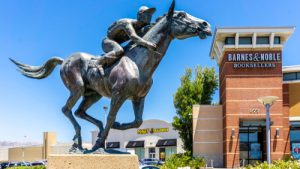
Photo credit: Dr Victor Wong/Shutterstock.com
Seabiscuit was an American champion thoroughbred racehorse who was foaled in Kentucky in 1933. The relatively diminutive bay stallion stood only 15.2 hands high. His 5-year racing career, which began in 1935, saw him win 33 races from 89 starts. However, Seabiscuit’s career got off to a fairly inauspicious start, which saw him win just 10 of his first 40 races. However, a year later, Seabiscuit was sold to a new owner and was subsequently assigned another trainer. It was then that his career really began to take off. In 1937, he won 11 of his 15 starts and was the USA’s leading money winner for the year.
Through 1938, Seabiscuit’s great run of success continued. In November 1938, he was pitched against War Admiral in a head-to-head contest that was dubbed “Race of the Century.” Seabiscuit was the underdog as the race’s firm favourite had just claimed the Triple Crown. However, against the odds Seabiscuit triumphed, winning the race by four lengths. He went on to be named the USA’s ‘Horse of the Year’ and also became the highest-earning racehorse of all time in the process.
In April 1940, Seabiscuit retired from racing to the Ridgewood Ranch near Willits, California. He died of a suspected heart attack 7 years later, just 6 days short of his 14th birthday. Two blockbuster films have been made of Seabiscuit’s life: The Story of Seabiscuit (1949) and Seabiscuit (2003). The latter was based on the best-selling book, Seabiscuit: An American Legend, authored by Laura Hillenbrand and published in 1999.
Man o’War (1917 – 1947)
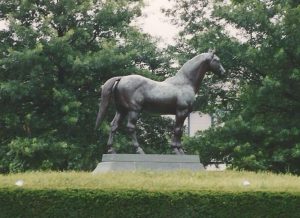
Photo credit: Creative Commons/(CC BY-SA 4.0)
Man o’ War nicknamed Big Red, was foaled in 1917 at the Nursery Stud in Lexington, Kentucky. The American Thoroughbred stallion is considered by many pundits to be the greatest racehorse of the 20th century. However, his career was brief, only lasting two seasons, 1919 and 1920, In his first season, Man o’ War, as a two-year-old, won 9 of his 10 starts. The victories included two of the USA’s most prestigious races of the time, the Hopeful Stakes and Belmont Futurity. Losing by a neck, his only defeat came at the hands of the fittingly named ‘Upset’ at the Saratoga Racecourse.
In the following season, in 1920, Man o’War won all 11 of the races in which he started. Additionally, he set seven-course speed records and accumulated record-breaking winnings for a horse of his time. His racing days ended with what was dubbed by the media as the “race of the century”. In the race, he triumph over triple crown winner Sir Barton, in a one-to-one race in the Kenilworth Park Gold Cup in Windsor, Ontario, Canada. After an undefeated season, the three-year-old Man o’ War was retired to stud in Lexington.
However, Man o’War wasn’t yet finished with influencing the world of horseracing. Amongst others, he sired the great champion War Admiral and was grandsire to the phenomenal Seabiscuit. Man o’ War died on 1 November 1947, aged 30, from a suspected heart attack. His funeral was broadcast live on NBC Radio.
Header image credit: Stefan Holm/Shutterstock.com
